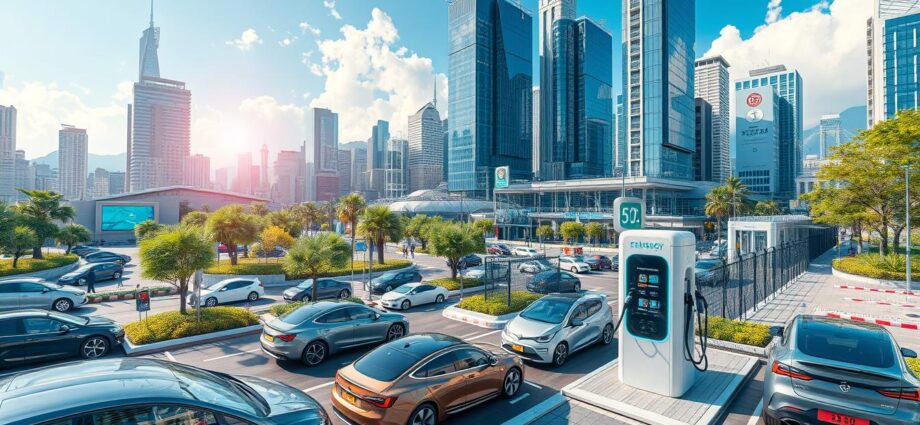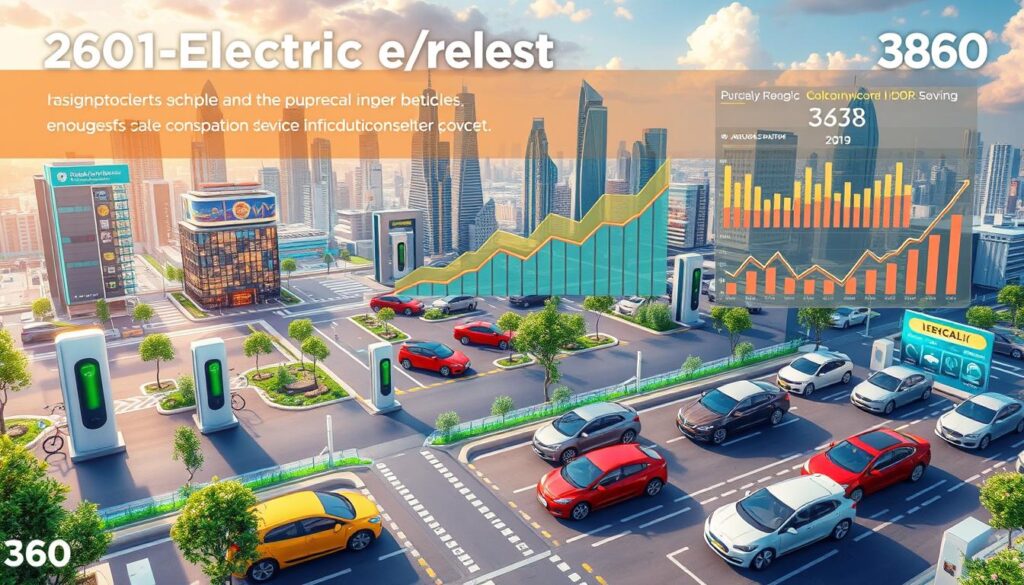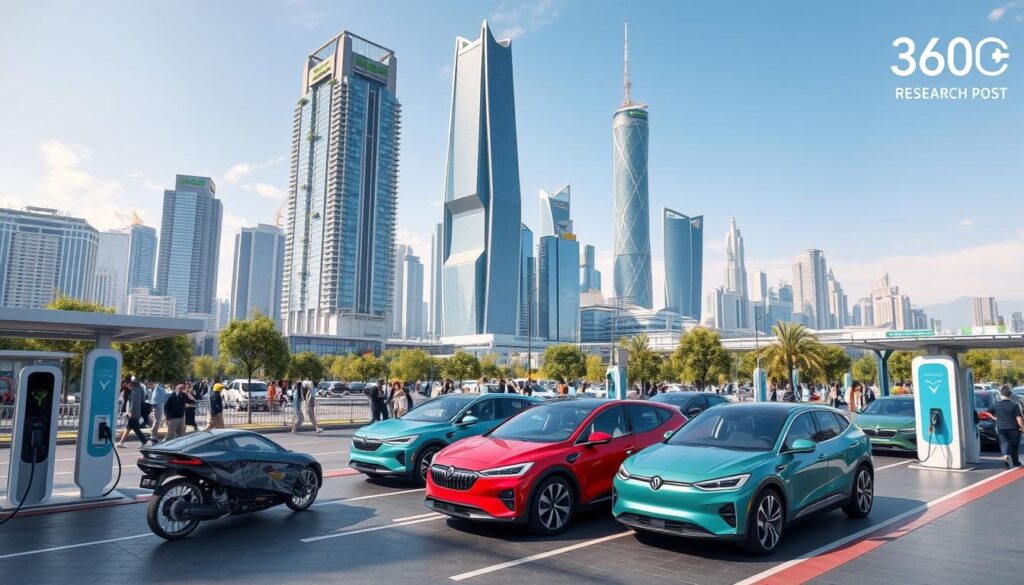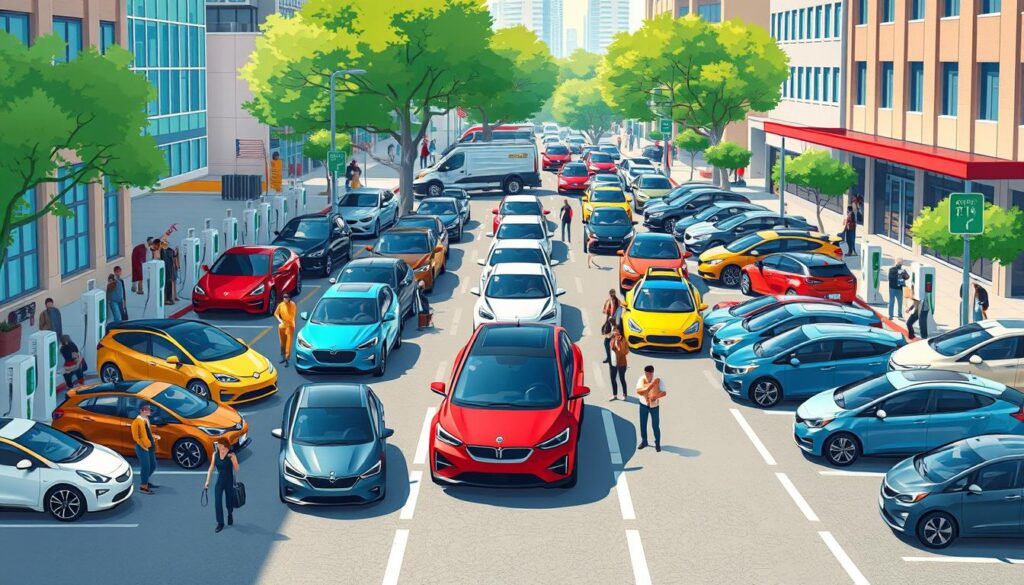The future of cars is electric. The electric vehicle (EV) market is growing fast. But will EVs soon rule our roads, or will growth slow down?
We’ll look at trends, forecasts, and tech changes in the EV market. We’ll see how demand in China and policy support in Europe and the U.S. are driving change. We’ll also talk about the challenges ahead1.
Investments in EVs and batteries in 2022 and 2023 are huge, over USD 275 billion and USD 195 billion, respectively. About USD 190 billion of this has been committed already2. In 2023, over 14 million EVs were sold worldwide, making up 16.5% of the market, up from 13% in 2022.
Key Takeaways
- Global light vehicle sales are expected to see modest growth of 1-3% over 2024-2026, with varying demand patterns across regions.
- EV sales growth rates remain solid in Europe, China, and the U.S. in early 2024, albeit slower compared to the spike over 2020-2021.
- Pricing dynamics, the margin dilutive effect of electric powertrains, and the market distortive profile of subsidies could weigh on EV sales growth in some markets.
- China’s pricing parity and the large range of EV models at every price segment will continue to drive increasing EV adoption.
- Investments in EV and battery manufacturing have surged, particularly in the U.S. and Europe, signaling the industry’s commitment to the electric future.
Overview: Global Electric Vehicle Market Outlook
The electric vehicle (EV) market is growing fast. By 2024, it’s expected to see around 17 million electric cars sold. This is a 25% increase from the first quarter of 20233.
Electric cars are becoming more popular. China is expected to see up to 45% of its cars be electric by 2024. Europe and the United States will also see significant increases, with 25% and over 11% of cars being electric, respectively3.
Projections and Forecasts
In 2023, nearly 14 million electric cars were sold worldwide. This is 18% of all cars sold3. Sales jumped by 35% from 2022 to 2023, showing rapid growth3.
Over 250,000 electric cars were sold every week in 2023. This shows how fast EVs are being adopted globally3.
Regional Trends and Drivers
China leads the market, with 60% of global electric car sales in 20233. Europe and the United States are also growing fast. Europe had 25% of the market, and the United States had 10%3.
Good policies, more models, and cheaper batteries are helping EVs grow. By 2035, half of all cars sold will be electric3.
From 2022 to 2023, over USD 500 billion was invested in EV and battery manufacturing. This shows the industry’s belief in electric cars3. In 2023, EV battery production met demand, with 2.2 terawatt-hours made and 750 gigawatt-hours needed3.
The EV market is set to keep growing. By 2040, there could be 730 million electric cars on the road. This growth will also lead to a $1.9 trillion charging infrastructure market by 20504.
China: Surging Demand and Production Capacity
China’s electric vehicle (EV) market is booming, making it the world leader5. For the first time, electric vehicles (NEVs) outsold traditional cars in Mainland China in July 20245. Experts predict that NEVs will make up 46% of the Chinese car market in 2024, up from 36% in 20235.
Chinese car makers now own 87% of the EV market, up from 83% in 20235. They are expected to keep this lead, with global brands improving to 25% by 20295.
EV Sales and Market Share
5 In the first half of 2024, China saw a 12% rise in BEV sales to 3.02 million units5. PHEV sales jumped by 85% to 1.92 million units5. The combined sales of PHEVs and REEVs grew by 83% in 2023 to 2.75 million units5.
By 2029, S&P Global Mobility expects PHEV and REEV sales to reach 24% of all car sales in China. BEVs will make up 51%, with NEVs accounting for 75% of sales5.
Battery and Component Manufacturing
6 In 2023, over 750 GWh of battery demand was seen globally, a 40% jump from 20226. China led with 415 GWh, followed by Europe with 185 GWh and the United States with about 100 GWh6. China dominates in battery production, holding 90% of cathode and over 97% of anode material capacity in 20237.
From 2009 to 2023, China invested around $230 billion in the EV industry, a significant increase in recent years7. In 2023, China was home to more than half of the world’s EVs, making it the largest market and producer.
| Metric | China | Europe | United States |
|---|---|---|---|
| EV Battery Demand (GWh, 2023) | 415 | 185 | 100 |
| EV Sales Growth Rate (YoY, 2023) | ~35% | >40% | >40% |
| Cathode Active Material Manufacturing Capacity (Global Share, 2023) | 90% | N/A | N/A |
| Anode Active Material Manufacturing Capacity (Global Share, 2023) | 97% | N/A | N/A |
7 China’s EV exports soared to 1.2 million units in 2023, up from less than 680,000 in 20225. The EU imposed tariffs of up to 36.3% on Chinese EVs, trying to compete with China’s low prices7. Despite losing national rebates, subsidies stayed the same in 2023 due to more sales tax exemptions for EVs.
Europe: Steady Growth Amid Policy Support
Europe’s car sales are expected to grow slowly, by 0-2%, from 2024 to 2026. This follows a big jump of 19% in 20238. Electric vehicle (EV) sales are still strong, thanks to good car sales in Russia, Turkey, and Western Europe8.
But, EV adoption might slow down, especially in Germany. This is because a subsidy for electric cars ended in December 20238.
EV Adoption and Incentives
The use of plug-in-hybrid-EVs (PHEVs) has barely changed since 2023 in big EU markets8. But, policies like the European Union’s Net Zero Industry Act are helping. They also make it easier for companies to invest in electric car parts9.
Europe has put about €80 billion into electric car projects since 20219. The goal to stop selling cars with combustion engines by 2035 is key for investors9. The next five years are crucial for Europe to make a big change towards green technology9.
“Europe needs to ramp up funding for innovative clean technologies with a new EU Green Investment Plan to support the deployment and manufacturing of clean technologies.”
United States: Gaining Momentum with Incentives
The United States is seeing a big jump in electric vehicle (EV) sales. This is thanks to government incentives and support. The federal government gives a tax credit of up to $7,500 for new EVs10.
States and local areas also offer extra help. For example, Colorado adds $2,000 to the federal credit10. Austin, Texas, even gives up to 50% off the cost of a home EV charger10.
But, these incentives can change based on how many EVs are sold10. EVs must meet certain battery size, weight, and emissions standards10. The $7,500 federal tax credit is currently available and will continue unless policy changes10.
Impact of Inflation Reduction Act
The Inflation Reduction Act (IRA) has greatly affected the EV market in the U.S. It changed the tax credit rules, requiring vehicles to be made in North America10. This has cut down the number of eligible EV models from over 40 to around 27 by January 2024.
Investments in EV and Battery Manufacturing
Despite the new rules, the IRA has led to over $60 billion in investments for EVs, mostly for battery making10. Big car companies like Volkswagen-backed Scout Motors, BMW, and Hyundai-Kia plan to make EVs in the U.S. to get IRA benefits.
The U.S. is making big strides in electric vehicles, thanks to incentives and support. The IRA and focus on making things in the U.S. will shape the future of EV sales and the car industry.
| Metric | Data | Source |
|---|---|---|
| Publicly Accessible Charging Stations in the US | Over 53,000 in 2023, with more than 137,000 charging ports | 11 |
| MPGe and Range of Light-Duty All-Electric Vehicles | Can exceed 130 MPGe and drive 100 miles on 25-40 kWh | 11 |
| U.S. Petroleum Imports and Consumption | Became a net exporter in 2020, with imports of 8.32 million barrels per day in 2022 remaining important; Transportation sector accounts for 30% of total U.S. energy needs and 70% of U.S. petroleum consumption | 11 |
| Battery Lifespan in Electric Vehicles | Predictive modeling indicates 12-15 years in moderate climates and 8-12 years in extreme climates | 11 |
“The Inflation Reduction Act has significantly impacted the EV market in the US, with changes to the tax credit requirements leading to a reduction in the number of eligible models. However, the legislation has also spurred substantial investments in domestic EV and battery manufacturing.”
The United States is set to keep moving forward in the electric vehicle market. This is thanks to government help, policy support, and more investments in making things in the U.S101112..
Pricing Trends and Competitive Landscape
The electric vehicle (EV) market is seeing fast changes in pricing. This is because manufacturers are adapting to a quickly changing competitive scene. The global market for battery electric vehicles hit $267.1 billion in 202213. Prices vary a lot in different places and types of vehicles.
Transaction Prices and Incentives
In the United States, a new EV costs about $47,200 on average, down 5.4% from December 202213. To get more people to buy EVs, car makers are offering more incentives. These incentives now make up 6.6% of the price on average, up from 3.2% a year ago13. This is especially true for luxury EVs.
In the Eurozone, car prices keep going up but at a slower rate. They grew by 1.8% in March 2024, down from 8% in December 202213. The Chinese EV market is getting very crowded. This leads to a big price competition as companies try to get more customers and make more money with cheaper batteries13.
| Metric | United States | Europe | China |
|---|---|---|---|
| Average EV Price (February 2024) | $47,200 | +1.8% YoY | Intense price competition |
| Incentive as % of Transaction Price (March 2024) | 6.6% | N/A | N/A |
The EV market is also changing because of new players. For example, Tesla cut the price of its Model Y RWD from $60,900 to $55,900 in just two weeks14. This shows how fast prices can change. Companies are lowering prices to get more customers, making the competition even fiercer14.
It’s very important for EV makers to set prices right to stay ahead and make money in this fast-changing market14. By improving their commercial skills, EV companies can make 3-10% more profit each year. This helps them make more money and stay ahead14.
“Companies in the EV market engage in a price war, slashing prices to attract customers, leading to intensified competition.”
Electric Vehicle: Electrification and Technology Advancements
The global electric vehicle (EV) market is seeing a big change towards battery electric vehicles (BEVs). In 2023, BEVs made up 16.5% of the global EV market, a big jump from 2.5% in 201915. Even though BEVs are becoming more popular, hybrid electric vehicles (HEVs) still have a key role, especially where EVs are more expensive than traditional cars.
BEVs are becoming more popular because of their price, the variety of models, and government support15. Improvements in battery technology and faster charging are also helping to overcome concerns about range and charging time15.
Battery Electric Vehicles (BEVs) vs Hybrid Electric Vehicles (HEVs)
The market share of BEVs and HEVs is changing in different places because of local policies and market conditions15. For example, in the European Union, electric cars make up 22% of the market. China and California are tied at 25%, while Japan and South Korea have 3% and 1.8%, respectively16.
New technologies like solid-state batteries and lightweight materials are making BEVs better15. These advancements improve performance and efficiency. They also make EVs more fun to drive15.
As EVs keep getting better, we can expect even more cool features. Things like contactless payments, vehicle-to-grid integration, and ultra-fast charging will make EVs even more appealing15.
“The rapid advancements in electric vehicle technology are transforming the way we think about transportation, offering greater efficiency, performance, and sustainability.”
Power Electronics: Driving Efficiency and Range
The electric vehicle (EV) industry is growing fast. Power electronics play a key role in making EVs better. They help control the flow of electricity in EVs.
Silicon Carbide (SiC) and Gallium Nitride (GaN)
The industry is moving to wide bandgap semiconductors like SiC and GaN. These materials are better than old silicon devices. They lose less power, make less heat, and switch faster.
This means EVs can go farther and move smoother. SiC and GaN help EVs perform better.
Inverters, On-Board Chargers, and DC-DC Converters
EVs have important power electronic parts like the traction inverter, onboard charger, and DC-DC converter. They help manage electricity flow and make charging faster.
Combining the onboard charger and DC-DC converter can save up to 25% in cost. It also slightly increases the vehicle’s range.
Also, faster charging is possible. Some EVs charge 33% quicker on 800V chargers than on 400V ones.
| Component | Function | Advantages of Wide Bandgap Semiconductors |
|---|---|---|
| Traction Inverter | Converts DC power from the battery to AC power for the electric motor | Improved efficiency, higher switching frequencies, and reduced heat generation |
| On-Board Charger | Converts AC power from the grid to DC power for charging the battery | Faster charging rates, reduced costs, and weight/volume savings through integration |
| DC-DC Converter | Steps down the high-voltage battery power to low-voltage for auxiliary systems | Increased efficiency, smaller size, and lower weight through integration with the onboard charger |
As EVs keep improving, power electronics will play an even bigger role. They will help make EVs more affordable and efficient. Car makers and suppliers are working hard to meet the demand for green cars.
Supply Chain and Manufacturing Innovations
The demand for electric vehicles (EVs) is skyrocketing, leading to big investments in the EV supply chain. In 2022 and 2023, over $275 billion was invested in EVs and $195 billion in batteries. About $190 billion of this has already been committed17. This investment is key to meet the expected rise in EV sales.
Experts predict that by 2030, EVs could make up 40% of car sales in the US. Some even think it could be over 50%17. This growth is driving the need for more efficient and reliable supply chains.
Investments are happening worldwide, not just in the US. China is preparing to export batteries, and Europe is boosting battery production. But, the industry still faces challenges like upgrading to 200mm silicon carbide wafers and spreading out the SiC supply chain.
Wafer and Component Supply
The EV supply chain relies on many key parts, like battery packs and motors. Moving to 200mm SiC wafers is crucial to meet demand. But, the SiC supply chain needs to grow beyond the US to avoid risks17.
| Component | Percentage of EV Value |
|---|---|
| Battery Pack & High Voltage Component | 50% |
| Motor | 15% |
| Brake, Wheel & Suspension | 10% |
| Body & Chassis | 15% |
| Low Voltage Electric Component | 10% |
As the EV market grows, manufacturers and suppliers must keep up. They need to ensure a steady supply of essential components171819.
Integration and Consolidation in the Industry
The electric vehicle (EV) industry is seeing more integration and consolidation. Automakers and suppliers are working together to make things more efficient. They are sharing EV platforms to speed up product development and save money20. Also, semiconductor suppliers are buying other companies to control their supply chains better21.
This teamwork is key to meeting electrification goals, avoiding delays, and cutting costs. The level of integration can range from mechanical to electronic, aiming to combine all power electronics into one unit20.
The EV industry’s push for integration and consolidation is similar to the auto industry’s past. It’s about having fewer, stronger companies21. This is due to the need to improve operations, use economies of scale, and build supply chains from scratch21.
Even with a demand slowdown, the EV industry is still strong. New startups are focusing on autonomous tech, and big players like Tesla and BYD are doing well21.
The success of EV industry integration and consolidation will depend on government support, policy stability, and overcoming supply chain hurdles2122.
“One out of 10 is considered a decent success ratio for entrepreneurial ventures in industries like EVs that require large capital requirements.”
– John Paul MacDuffie, Wharton management professor
Challenges and Opportunities
The electric vehicle (EV) market is growing fast, but it faces challenges and opportunities. A big problem is the lack of ev charging infrastructure across the U.S. Many people don’t buy EVs because they worry about running out of power or finding charging stations.
Government and industry are working hard to fix this. They aim to build more charging stations. But, they need to do it fast as EV sales are rising.
Infrastructure and Charging Networks
Fixing the ev charging infrastructure is key to the EV market’s success. Setting up charging stations costs a lot of money. But, the government is helping with funding to support this effort.
Raw Material Supply and Sustainability
The EV industry also struggles with getting the right raw materials. These include lithium, cobalt, and nickel for batteries. Finding a steady and ethical ev raw material supply is vital for the EV market’s future.
Recycling and finding new battery types can help. This makes the EV industry more sustainable.
By tackling these issues, the EV industry can grow and help make transportation greener2324.
“The availability and accessibility of charging infrastructure is a crucial factor, as the lack of a widespread and reliable charging network can hamper EV adoption.”
Conclusion
The global electric vehicle (EV) market outlook looks bright, with big growth expected in the future. This growth is thanks to new tech, government support, and changing what people want. The EV industry trends show that electric cars will become more important in how we travel25.
Several things are driving this change. More people are choosing battery electric vehicles (BEVs). New tech like silicon carbide (SiC) and gallium nitride (GaN) is making EVs better and more efficient. Also, making more batteries and parts is key to meeting demand2526.
But, the EV world faces some hurdles. We need more charging spots, better raw materials, and to be more green. As we move forward, working together and combining efforts will help meet our goals. This will make electric cars more affordable and better for everyone26.
FAQ
What are the global light vehicle sales projections for 2024-2026?
Sales of light vehicles are expected to grow by 1-3% from 2024 to 2026. This growth will vary across different regions like China, Europe, and the U.S.
How is the electric vehicle (EV) market performing globally?
EV sales are still growing in Europe, China, and the U.S. in early 2024. But the growth rate is slower than it was from 2020 to 2021. In 2023, EVs made up 16.5% of the global market, up from 13% in 2022 and 2.5% in 2019.
What are the key factors impacting EV sales growth in different regions?
Several factors are affecting EV sales growth. These include EV prices, the cost of electric powertrains, and government subsidies. In the U.S. and Europe, these factors might slow down EV sales growth. But in China, affordable prices and a wide range of models are driving EV adoption.
What is the outlook for China’s EV market?
China’s EV market is expected to grow by 2-4% in 2024. This growth is due to affordable prices and a variety of EV models. In 2023, EVs made up 25.5% of China’s market.
How is the EV market performing in Europe?
Europe’s light vehicle sales are expected to grow by 0-2% from 2024 to 2026. EV sales in Europe are still growing, but at a slower pace. In Germany, the end of EV subsidies has slowed down the adoption of electric vehicles.
What is the outlook for the EV market in the United States?
The U.S. EV market is expected to see a slight rebound in 2025 and 2026. However, sales will still be below pre-pandemic levels. The Inflation Reduction Act has reduced the number of eligible electric cars but has also boosted EV investments.
How are electric vehicle (EV) pricing patterns evolving across regions?
EV prices are expected to be weaker in 2024 and 2025 compared to 2023. In the U.S., the average new vehicle price was about ,200 in February 2024, down 5.4% from December 2022. In the Eurozone, car prices are still rising but at a slower pace. In China, the EV market is becoming more competitive, leading to lower prices.
What is the trend in the adoption of battery electric vehicles (BEVs) versus hybrid electric vehicles (HEVs)?
The global EV market is shifting quickly towards BEVs. BEVs’ market share rose from 2.5% in 2019 to 16.5% in 2023. However, HEVs are still important, especially where the price difference between EVs and traditional cars is high.
How are power electronics technologies like silicon carbide (SiC) and gallium nitride (GaN) impacting the EV industry?
Wide bandgap semiconductors like SiC and GaN are improving EV performance and efficiency. SiC MOSFETs are being adopted in EV inverters and chargers for their advantages. GaN technologies are also set to enter these markets soon.
What is the current state of the EV supply chain and manufacturing landscape?
The EV industry has seen over 5 billion in investment announcements since 2022. Around 0 billion has been committed. Challenges include the transition to 200mm SiC wafers and globalizing SiC supply beyond the U.S.
How is the EV industry seeing increasing levels of integration and consolidation?
Automakers are sharing EV platforms, and semiconductor suppliers are integrating and acquiring companies. This collaboration is key for meeting electrification targets, avoiding bottlenecks, and reducing costs.
What are the key challenges and opportunities facing the mass adoption of electric vehicles (EVs)?
Key challenges include charging infrastructure, raw material supply, and sustainability. Opportunities lie in recycling and developing new battery chemistries.
Source Links
- https://www.iea.org/reports/global-ev-outlook-2024/outlook-for-electric-mobility
- https://www.spglobal.com/ratings/en/research/articles/240425-global-auto-sales-forecasts-slower-ev-growth-offers-temporary-relief-to-legacy-automakers-13084917
- https://www.iea.org/reports/global-ev-outlook-2024/executive-summary
- https://assets.bbhub.io/professional/sites/24/2431510_BNEFElectricVehicleOutlook2023_ExecSummary.pdf
- https://www.spglobal.com/mobility/en/research-analysis/fuel-for-thought-electric-vehicle-adoption-trends-china.html
- https://www.iea.org/reports/global-ev-outlook-2024/trends-in-electric-vehicle-batteries
- https://www.carbonbrief.org/qa-the-global-trade-war-over-chinas-booming-ev-industry/
- https://www.mckinsey.com/industries/automotive-and-assembly/our-insights/europes-economic-potential-in-the-shift-to-electric-vehicles
- https://www.transportenvironment.org/articles/a-smart-industrial-policy-to-fast-charge-europes-electric-vehicles-revolution
- https://www.xcelerateauto.com/blog/ev-government-incentives-and-policies
- https://afdc.energy.gov/fuels/electricity-benefits
- https://www.iea.org/reports/global-ev-outlook-2024/trends-in-electric-cars
- https://medium.com/@locationscloud/electric-vehicle-ev-market-analysis-and-trends-9657276c4100
- https://taylorwells.com.au/electric-vehicle-price-trends/
- https://witricity.com/media/blog/advances-in-ev-technology
- https://www.iea.org/reports/global-ev-outlook-2021/trends-and-developments-in-electric-vehicle-markets
- https://rmi.org/the-ev-battery-supply-chain-explained/
- https://www.pwc.com/us/en/industries/industrial-products/library/electric-vehicles-supply-chain.html
- https://ir.library.illinoisstate.edu/cgi/viewcontent.cgi?article=1007&context=fpmqm
- https://www.spglobal.com/mobility/en/research-analysis/2024-ev-forecast-the-supply-chain-charging-network-and-battery.html
- https://knowledge.wharton.upenn.edu/article/who-will-survive-a-shakeout-in-the-electric-vehicle-market/
- https://www.assemblymag.com/articles/98771-ev-industry-is-at-a-crossroads
- https://www.eesi.org/articles/view/on-the-move-unpacking-the-challenges-and-opportunities-of-electric-vehicles
- https://evchargingsummit.com/blog/challenges-facing-the-ev-industry-today/
- https://www.nexamp.com/blog/pros-and-cons-of-electric-cars
- https://www.mdpi.com/2076-3417/13/10/6016





